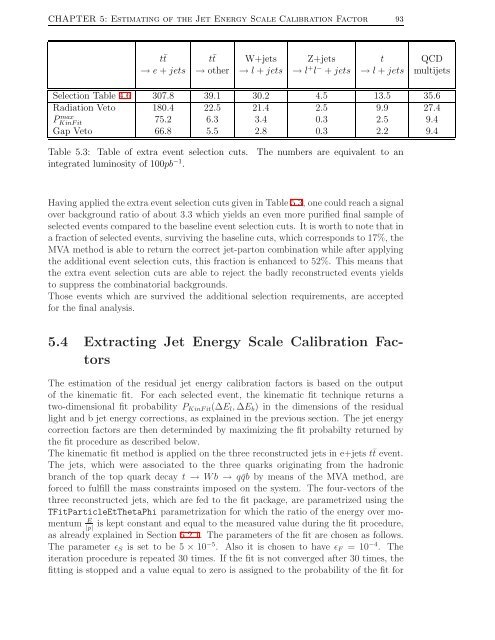Measurement of the Jet Energy Scale in the CMS experiment ... - IIHE
Measurement of the Jet Energy Scale in the CMS experiment ... - IIHE
Measurement of the Jet Energy Scale in the CMS experiment ... - IIHE
You also want an ePaper? Increase the reach of your titles
YUMPU automatically turns print PDFs into web optimized ePapers that Google loves.
CHAPTER 5: Estimat<strong>in</strong>g <strong>of</strong> <strong>the</strong> <strong>Jet</strong> <strong>Energy</strong> <strong>Scale</strong> Calibration Factor 93t¯t t¯t W+jets Z+jets t QCD→ e + jets → o<strong>the</strong>r → l + jets → l + l − + jets → l + jets multijetsSelection Table 4.6 307.8 39.1 30.2 4.5 13.5 35.6Radiation Veto 180.4 22.5 21.4 2.5 9.9 27.4PK<strong>in</strong>Fit max75.2 6.3 3.4 0.3 2.5 9.4Gap Veto 66.8 5.5 2.8 0.3 2.2 9.4Table 5.3: Table <strong>of</strong> extra event selection cuts. The numbers are equivalent to an<strong>in</strong>tegrated lum<strong>in</strong>osity <strong>of</strong> 100pb −1 .Hav<strong>in</strong>g applied <strong>the</strong> extra event selection cuts given <strong>in</strong> Table 5.3, one could reach a signalover background ratio <strong>of</strong> about 3.3 which yields an even more purified f<strong>in</strong>al sample <strong>of</strong>selected events compared to <strong>the</strong> basel<strong>in</strong>e event selection cuts. It is worth to note that <strong>in</strong>a fraction <strong>of</strong> selected events, surviv<strong>in</strong>g <strong>the</strong> basel<strong>in</strong>e cuts, which corresponds to 17%, <strong>the</strong>MVA method is able to return <strong>the</strong> correct jet-parton comb<strong>in</strong>ation while after apply<strong>in</strong>g<strong>the</strong> additional event selection cuts, this fraction is enhanced to 52%. This means that<strong>the</strong> extra event selection cuts are able to reject <strong>the</strong> badly reconstructed events yieldsto suppress <strong>the</strong> comb<strong>in</strong>atorial backgrounds.Those events which are survived <strong>the</strong> additional selection requirements, are acceptedfor <strong>the</strong> f<strong>in</strong>al analysis.5.4 Extract<strong>in</strong>g <strong>Jet</strong> <strong>Energy</strong> <strong>Scale</strong> Calibration FactorsThe estimation <strong>of</strong> <strong>the</strong> residual jet energy calibration factors is based on <strong>the</strong> output<strong>of</strong> <strong>the</strong> k<strong>in</strong>ematic fit. For each selected event, <strong>the</strong> k<strong>in</strong>ematic fit technique returns atwo-dimensional fit probability P K<strong>in</strong>Fit (∆E l , ∆E b ) <strong>in</strong> <strong>the</strong> dimensions <strong>of</strong> <strong>the</strong> residuallight and b jet energy corrections, as expla<strong>in</strong>ed <strong>in</strong> <strong>the</strong> previous section. The jet energycorrection factors are <strong>the</strong>n determ<strong>in</strong>ded by maximiz<strong>in</strong>g <strong>the</strong> fit probabilty returned by<strong>the</strong> fit procedure as described below.The k<strong>in</strong>ematic fit method is applied on <strong>the</strong> three reconstructed jets <strong>in</strong> e+jets t¯t event.The jets, which were associated to <strong>the</strong> three quarks orig<strong>in</strong>at<strong>in</strong>g from <strong>the</strong> hadronicbranch <strong>of</strong> <strong>the</strong> top quark decay t → Wb → q¯qb by means <strong>of</strong> <strong>the</strong> MVA method, areforced to fulfill <strong>the</strong> mass constra<strong>in</strong>ts imposed on <strong>the</strong> system. The four-vectors <strong>of</strong> <strong>the</strong>three reconstructed jets, which are fed to <strong>the</strong> fit package, are parametrized us<strong>in</strong>g <strong>the</strong>TFitParticleEtThetaPhi parametrization for which <strong>the</strong> ratio <strong>of</strong> <strong>the</strong> energy over momentumE is kept constant and equal to <strong>the</strong> measured value dur<strong>in</strong>g <strong>the</strong> fit procedure,|p|as already expla<strong>in</strong>ed <strong>in</strong> Section 5.2.1. The parameters <strong>of</strong> <strong>the</strong> fit are chosen as follows.The parameter ǫ S is set to be 5 × 10 −5 . Also it is chosen to have ǫ F = 10 −4 . Theiteration procedure is repeated 30 times. If <strong>the</strong> fit is not converged after 30 times, <strong>the</strong>fitt<strong>in</strong>g is stopped and a value equal to zero is assigned to <strong>the</strong> probability <strong>of</strong> <strong>the</strong> fit for
















